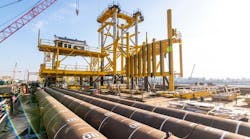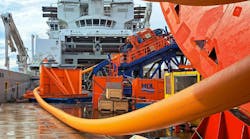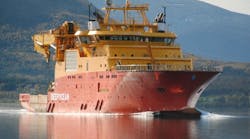Offshore staff
ZUG, Switzerland – Preparations have started for welding together two of the three sections of the first 1,224-km (760-mi) Nord Stream gas pipeline in the Baltic Sea.
They will be joined on the seabed in 80 m (262 ft) water depth off the coast of Finland under a process expected to take around two weeks. Technical completion of the first of the twin pipelines should be achieved in June, when the final section is welded onto the pipeline off the Swedish island of Gotland in 110 m (361 ft) of water.
The pipeline will operate without an intermediate compressor station, but with three different design pressures and pipe wall thicknesses to accommodate falling gas pressure during the journey from Russia to the landfall in northern Germany.
Connection of these three sections is being performed offshore where the design pressure changes from 220 to 200 bar (3,191-2,900 psi) and from 200 to 177.5 bar (2,900-2,574 psi), respectively.
Each will be gauged and pressure-tested before being joined via hyperbaric tie-ins and subsequently linked to the landfalls in Russia and Germany.
Technip is managing the hyperbaric tie-ins from its new DSVSkandi Arctic, using equipment supplied by the Pipeline Repair System (PRS) pool administered by Nord Stream partner Statoil.
The procedure takes place on the seabed in a specially created dry zone (underwater welding habitat). Welding operations are controlled remotely from theSkandi Arctic, with divers assisting and monitoring the subsea construction work.
Skandi Arctic transports and operates all equipment needed to move, lift, cut, and weld the pipeline sections together. Pipe handling frames move the pipe ends into tie-in position. They also can shift the pipeline sections sideways to line them up for welding.
05/11/2011




